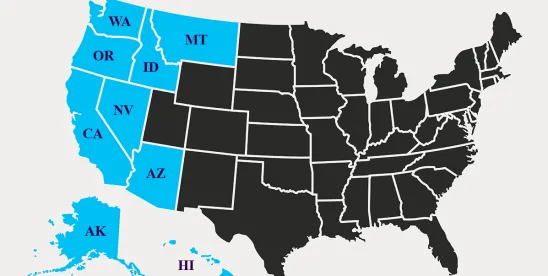On July 12, 2024, in a keenly awaited decision, the U.S. District Court for the Northern District of California determined that Workday, Inc. (“Workday”), a provider of AI-infused human resources (HR) software, can be held liable under Title VII of the Civil Rights Act of 1964 (Title VII), the Age Discrimination in Employment Act of 1967 (ADEA), and the Americans with Disabilities Act (ADA) (collectively the “Anti-Discrimination Laws”) as an agent of the corporate clients that hire Workday to screen and source candidates for employment by utilizing its AI-infused decision-making tools.
In noting that “[d]rawing an artificial distinction between software decisionmakers and human decisionmakers would potentially gut anti-discrimination laws in the modern era,” the court underscored the EEOC’s admonition, which we discussed in our previous post, that employers delegating their hiring protocols to AI must do so cognizant of the potential discriminatory impacts of such use. See Opinion at 10. Thus, the court allowed plaintiff Derek Mobley’s disparate impact claim to proceed, finding that Mobley’s allegations supported a plausible inference that Workday’s screening algorithms automatically rejected his applications based on protected characteristics rather than his qualifications.
Prior Proceedings
Mobley filed his initial complaint as a putative class action on February 21, 2023, alleging claims against Workday as an “employment agency” for disparate impact and intentional discrimination under the Anti-Discrimination Laws. His complaint centered on his allegation that he applied for “at least 80-100 positions that upon information and belief use Workday, Inc. as a screening tool for talent acquisition and/or hiring” and “has been denied employment each and every time.” Complaint at 10.
The court dismissed Mobley’s initial complaint on the ground that Mobley did not sufficiently allege that Workday was an “employment agency” as defined under the Anti-Discrimination Laws. The Court, however, granted Mobley an opportunity to amend his Complaint, which he did on February 20, 2024. In his amended complaint, Mobley alleged—in addition to his “employment agency” theory—that Workday “acts as an agent” of employers that use its service because “[c]lient-employers delegate to Workday certain aspects of the employers’ selection decisions,” (Amended Complaint at 25) that employers “directed job applicants to the Workday job screening platform,” and that this process is the “only means an employee who applies for a job with an employer who uses the Workday platform can obtain employment.” Id. at 26. Mobley also alleged a third theory of liability, namely, that Workday is an “indirect employer” because it contracts with employers and it has the ability to “interfere and exert peculiar control over the prospective employee’s relationship with the direct employer.” Id.
Workday’s Second Motion to Dismiss
On March 12, 2024, Workday filed a motion to dismiss Mobley’s amended complaint. Among other things, Workday argued that, unlike traditional employment agencies, it does not “procure” applicants. Workday also argued that it is not an “agent” of its employer-customers because it did not exercise an “administrative function traditionally exercised by the employer.” Motion at 9. As we previously reported, in an unexpected twist, the U.S. Equal Employment Opportunity Commission (EEOC) filed an amicus brief in opposition to Workday’s motion to dismiss, arguing that Workday is an “employment agency,” because its screening and referral activities are “classically associated with employment agencies,” and that Workday is an agent of employers because, as alleged by Mobley, employers delegate control of significant aspects of their hiring process to Workday, by referring candidates for further consideration or instead, rejecting them. Brief at 5.
On May 14, 2024, the court conducted a hearing, providing a set of questions to the parties in advance. The court’s questions indicated a concern about allowing software vendors to be outside the scope of the Anti-Discrimination Laws. For example, the court asked “whether any entity would be liable where a software vendor intentionally provides employers a service that the vendor knows automatically screens out all applicants who previously attended historically black colleges…” Notice of Questions at 1. The court asked whether the decision to reject a job candidate rather than invite them for an interview constitutes an “administrative function traditionally exercised by the employer” in its hiring process. Id.
“Agent of Employer”
In its July 12, 2024 order, the court found that Workday can be held liable as an “agent” of an employer under the Anti-Discrimination Laws. The court explained that each of the Anti-Discrimination Laws “prohibit discrimination not just by employers themselves, but also agents of those employers.” Opinion at 5. The court also relied on the “plain language of the federal anti-discrimination statutes” which “define the term ‘employer’ as a ‘person engaged in an industry affecting commerce…and ‘any agent’ of such a person.” Opinion at 6 (emphasis added). It also relied on an Eleventh Circuit decision from twenty years ago, Williams v. City of Montgomery, 742 F.2d 586, 589 (11th Cir. 1984) that held “an employer’s agent may be independently liable when the employer has delegated to the agent ‘functions [that] are traditionally exercised by an employer.’”
The court concluded that Mobley sufficiently alleged that “Workday’s customers delegate traditional hiring functions, including rejecting applicants, to the algorithmic decision-making tools provided by Workday,” and noted that, according to the allegations, “Workday’s software is not simply implementing in a rote way the criteria that employers set forth, but is instead participating in the decision-making process by recommending some candidates to move forward and rejecting others.” Opinion at 9. The court also highlighted Mobley’s allegations that Workday’s software can “automatically disposition[] or move[] candidates forward in the recruiting process.” Opinion at 9. Therefore, the court found, “Workday’s tools are engaged in conduct that is at the heart of equal access to employment opportunities.” Having concluded that Workday could be liable as an “agent,” the court did not address Mobley’s argument that Workday is an “indirect employer.”
“Employment Agency”
On the other hand, the court rejected Mobley’s argument that Workday is an “employment agency,” which is separately defined by the Anti-Discrimination laws to include a person who “procure[s] employees for an employer.” Opinion at 12. The court found that Mobley “does not allege that Workday procures job opportunities for employees” but rather, that Mobley “allegedly finds job postings on his own, and his interaction with Workday does not begin until after he has decided to apply to a particular opportunity.” Opinion at 12. Notably, the court rejected the EEOC’s interpretation of “employment agency” asserted in its amicus brief.
Next, the court addressed Workday’s argument that construing Workday as an “agent” would render the narrower definition of “employment agency” superfluous. It reasoned that “employment agencies face a different set of restrictions than employers: employment agencies are liable when they ‘fail or refuse to refer’ individuals for consideration by employers on prohibited bases, but they are not subject to prohibitions applicable to employers in carrying out their traditional functions, such as hiring, discharging, compensating, or promoting employees.” Opinion at 7. The court explained that “[l]iability as an employment agency and liability as the agent of an employer are thus not coextensive.” Opinion at 7.
Disparate Impact and Intentional Discrimination Claims
Having addressed the threshold questions concerning the scope of the Anti-Discrimination Laws, the court next addressed Mobley’s substantive disparate impact and intentional discrimination allegations. The court found that Mobley sufficiently alleged all of the elements of a disparate impact claim (specific employment practice, statistical disparity, and causation). Notably, the court reasoned that the “sheer number of rejections and the timing of those decisions, coupled with [Mobley’s] allegations that Workday’s AI systems rely on biased training data support a plausible inference that Workday’s screening algorithms were automatically rejecting Mobley’s applications based on a factor other than his qualifications, such as a protected trait.” Opinion at 15 (citations omitted). In reaching this conclusion, the court relied on “academic and other literature about bias in data models and algorithms.” Opinion at 16.
Finally, the court dismissed Mobley’s intentional discrimination claims, on the grounds that they failed to demonstrate the element of intent. The court explained that it was insufficient for Mobley to merely allege that Workday was “aware” of adverse effects of its applicant screening tools. Opinion at 18. The court did, however, hold that Mobley satisfied the other elements of intentional discrimination, and left the door open for Mobley to seek leave to amend his complaint and add back his intentional discrimination claims “if discovery reveals evidence of Workday’s discriminatory intent.” Id.
Takeaways
This first-of-its-kind decision holds that a vendor of AI employment tools may be liable to private plaintiffs under Anti-Discrimination Laws as an “agent” of the employer for disparate impact claims. The impact of this decision should not be overstated, as it may still be appealed, and courts in different jurisdictions may arrive at different conclusions in interpreting the same Anti-Discrimination Laws which apply nationwide. In addition, while the court determined that Mobley’s allegations support a plausible inference that Workday’s algorithms considered illicit factors in rejecting his applications, only information produced during discovery will determine whether the algorithmic model inputs or outputs evidence either intentional disparate treatment discrimination or disparate impact discrimination, as indicated by applying the generally accepted Four Fifths (4/5ths) test.
At the same time, Mobley’s amended complaint offers a blueprint that could open the floodgates for private plaintiffs to bring copycat suits based on little more than being rejected by potential employers using AI-screening tools. Many questions, however, still remain unanswered by this decision. While a software vendor may be an “agent” of an employer, the court was not presented with the question of the extent of an employer’s liability for its use or reliance on a software vendor. Additionally, the court has not yet address the scope of damages available, which is important in light of the incredibly high volume of applications in the modern software ecosystem. In light of this decision, employers and software vendors should consider assessing their contracts, including provisions pertaining to liability for discrimination claims. Employers should also consider taking an inventory of their AI systems to assess potential areas of risk.
Given that the Uniform Guidelines on Employee Selection Procedures and the Office of Federal Contract Compliance Programs (OFCCP) Revised Order No. 4 both require employers to undertake applicant flow analyses, it is also critically important to define the term “applicant,” particularly considering the internet applicant rule as defined by the OFCCP. This case is a reminder for employers to distinguish between an uninvited showing of interest in employment, e.g., unsolicited resumes, and one who satisfies an employer’s requirements to become an applicant, e.g., submits a completed application form provided by the employer. An uninvited showing of interest is just that and the candidate should be required to satisfy the employer’s applications procedures to be considered an “applicant.”
To the extent an employer uses an AI-based tool from a third party, the employer and vendor should have a joint understanding of how the tool will be utilized to make employment decisions. This court concluded that Workday acts as an agent for its employer-clients because its tools allegedly “perform a traditional hiring function of rejecting candidates at the screening stage and recommending who to advance to subsequent stages.” Vendors, however, may attempt to mitigate the risk of liability by ensuring that their employer-clients at all times maintain control over how the parties implement the AI tool to assist with employment decisions.
Finally, although this court concluded that Workday does not operate as an employment agency, vendors that develop recruiting and sourcing tools should review the extent to which such tools procure candidates, and the role the tools play in their employer-clients’ recruiting and hiring efforts. Vendors engaged primarily in the development and sale of recruiting tools may now be at higher risk of being named as employment agencies under the Anti-Discrimination Laws and should plan accordingly.







 />i
/>i

